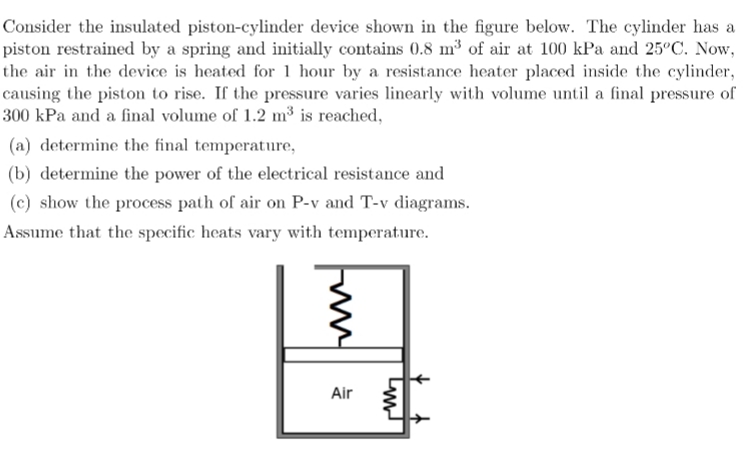Consider the insulated piston-cylinder device shown in the figure below. The cylinder has a piston restrained by a spring and initially contains 0.8 m³ of air at 100 kPa and 25°C. Now, the air in the device is heated for 1 hour by a resistance heater placed inside the cylinder, causing the piston to rise. If the pressure varies linearly with volume until a final pressure of 300 kPa and a final volume of 1.2 m³ is reached, (a) determine the final temperature, (b) determine the power of the electrical resistance and (c) show the process path of air on P-v and T-v diagrams. Assume that the specific heats vary with temperature. Air ww
Consider the insulated piston-cylinder device shown in the figure below. The cylinder has a piston restrained by a spring and initially contains 0.8 m³ of air at 100 kPa and 25°C. Now, the air in the device is heated for 1 hour by a resistance heater placed inside the cylinder, causing the piston to rise. If the pressure varies linearly with volume until a final pressure of 300 kPa and a final volume of 1.2 m³ is reached, (a) determine the final temperature, (b) determine the power of the electrical resistance and (c) show the process path of air on P-v and T-v diagrams. Assume that the specific heats vary with temperature. Air ww
Principles of Heat Transfer (Activate Learning with these NEW titles from Engineering!)
8th Edition
ISBN:9781305387102
Author:Kreith, Frank; Manglik, Raj M.
Publisher:Kreith, Frank; Manglik, Raj M.
Chapter3: Transient Heat Conduction
Section: Chapter Questions
Problem 3.12P
Related questions
Question

Transcribed Image Text:Consider the insulated piston-cylinder device shown in the figure below. The cylinder has a
piston restrained by a spring and initially contains 0.8 m³ of air at 100 kPa and 25°C. Now,
the air in the device is heated for 1 hour by a resistance heater placed inside the cylinder,
causing the piston to rise. If the pressure varies linearly with volume until a final pressure of
300 kPa and a final volume of 1.2 m³ is reached,
(a) determine the final temperature,
(b) determine the power of the electrical resistance and
(c) show the process path of air on P-v and T-v diagrams.
Assume that the specific heats vary with temperature.
Air
Expert Solution
This question has been solved!
Explore an expertly crafted, step-by-step solution for a thorough understanding of key concepts.
Step by step
Solved in 4 steps with 2 images

Knowledge Booster
Learn more about
Need a deep-dive on the concept behind this application? Look no further. Learn more about this topic, mechanical-engineering and related others by exploring similar questions and additional content below.Recommended textbooks for you

Principles of Heat Transfer (Activate Learning wi…
Mechanical Engineering
ISBN:
9781305387102
Author:
Kreith, Frank; Manglik, Raj M.
Publisher:
Cengage Learning

Principles of Heat Transfer (Activate Learning wi…
Mechanical Engineering
ISBN:
9781305387102
Author:
Kreith, Frank; Manglik, Raj M.
Publisher:
Cengage Learning